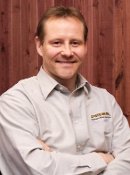Pasi Lautala

- MS Civil Engineering 1997
- PhD Civil Engineering 2007
Mission: Build a Great Northern Railway
by Jennifer Donovan
Pasi Lautala ’97 ’07 knows about cold climates. He’s from Finland, where it snows much the way it does in Houghton. He knows what arctic temperatures and freezing or thawing ground can do to railroad tracks and ties: heaving them, twisting them, turning them dysfunctional in a dozen different ways.
And as director of Tech’s Rail Transportation Program, Lautala has some pretty good ideas about addressing such problems. So when alumnus Paul Metz ’68—now a professor of mining and geological engineering at the University of Alaska Fairbanks—was asked to head a feasibility study on connecting existing Alaskan rail lines with those in Canada, he turned to his alma mater for help.
Lautala’s task: to look at what other countries with arctic railroads are doing, define the challenges, and identify solutions that have been tried, successfully or unsuccessfully.
To do that, he had to roam the globe, examining the design, construction, and maintenance practices and problems of cold-climate railroads. The study took him to Alaska, Russia, Scandinavia, Canada, and China, where he examined rail lines in places as remote as Siberia and Tibet.
First he needed to determine what has worked and what hasn’t. So he talked with rail industry leaders and with the people who actually build and maintain the tracks.
What Lautala learned surprised him.
"I was amazed to discover that many countries are planning or building new rail lines in very cold climates," he said. "And mostly they aren’t for passenger travel. They are related to natural resource development, particularly transportation for the mining industry."
That’s exactly the kind of rail line that Alaska and Canada are considering.
From Fort Saskatchewan to Fangshan, from Omsk to Lhasa, Lautala found that most of the key challenges of building and maintaining railroads under arctic conditions are the same: how different types of permafrost affect the substructure under the track; problems with drainage, ice, snow, and wind; and constructing track in transitional situations—from ground embankments to bridges and back to embankments, from permafrost to non-permafrost, between marshy bog and rock-bound soil.
Another challenge—less tangible but no less important—turned out to be a lack of data or inaccurate data. "There is a wealth of information in the railroad industry that has never been written down or compiled," Lautala explains. "This is not a well-researched academic field."
Although he returned impressed with the cold-weather engineering accomplishments of many lands, for Lautala, China’s Qinghai-Tibet Railroad took the prize. "It is the most recently built cold-climate railroad, and it is a stunning engineering feat," he said of the world’s highest railroad. Rising to 16,640 feet above sea level, more than 80 percent of the journey from Golmud to Lhasa is at elevations above 13,000 feet. The railroad also boasts the highest tunnel through permafrost in the world, at Fenghuoshan.
The Qinghai-Tibet railroad took four years to build, opening in 2006. All sorts of special equipment had to be designed: oxygen outlets for passengers and special insulation for the cars, which must climb approximately eight hundred miles of windblown track through temperatures that can dip to forty degrees below zero.
It nearly took Lautala’s breath away. "In the middle of nowhere, suddenly you have this magnificent railroad," he says.
Lautala visited the sky-high railroad at the invitation of a British film group that was filming a documentary for National Geographic International. He spent two weeks in China with a film crew that followed his train journey from Beijing to Tibet. The documentary, the second in a series of four focusing on megastructures, is slated to air in mid-2011.
While Lautala identified the problems facing cold-climate railroads, he also assessed a variety of innovative solutions. Dry bridges, crushed rock embankments, insulation, and heating pipes called thermosyphons are among the engineered answers to cold-climate questions that he evaluated.
Lautala submitted his report to Metz, who is incorporating it into his larger study on connecting the Alaskan and Canadian rail systems. The University of Calgary is a partner in the study, as well as Michigan Tech and the University of Alaska Fairbanks. The report also goes to the Rails to Resources Commission, appointed to assess the costs and revenue-producing potential of a rail line linking northern Canada with Alaska.
Meanwhile, the enormous project is progressing, says Metz. "One environmental impact statement is done; another is being done for a track connection to a port, and the money has been appropriated for the first hundred miles of track," he reports. A joint project of the US and Canadian governments and private industry, the northern rail line is estimated to ultimately cost between $7 billion and $10 billion.
The potential pay-offs are many. Building and maintaining the rail line will create jobs. It will enable mines to open and make consumer goods more accessible in remote locations. There is even a potential for passenger service, although that is not the primary focus of the planners.
But whatever is finally done with his data, Lautala had fun gathering it. "There are a couple of aspects of our cold climate railroad research project that have really fascinated me," he says. "Cold-climate railroads represent perhaps the most complicated version of rail transportation. Not only are they in remote locations where just getting there may take days, but they also face the most drastic changes in environmental conditions year-round. The ability of these railroads to provide reliable service even during the harshest winters is plain spectacular.
"It also was fascinating to see the difference in approaches various countries have used to solve similar challenges," Pasi says. "One country may simply add granular materials to the railroad bed each year, while another has developed very sophisticated engineering solutions to avoid most annual maintenance. As far as I can see, there is really no consensus which approach is better, so I guess we still have some work to do."
Excerpt from MTU Magazine, Vol.48 #3